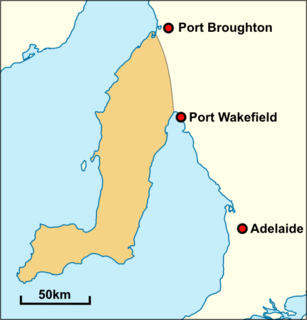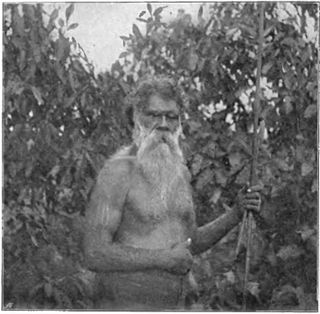The Diyari, alternatively transcribed as Dieri, is an Indigenous Australian group of the South Australian desert originating in and around the delta of Cooper Creek to the east of Lake Eyre.

The township of Yarram is in Victoria, Australia, in the Shire of Wellington, located in the southeast of Gippsland. At the 2016 census, the population of the town was 2,135. The town is the regional centre of a prosperous farming district. It has a vibrant community, which remains dedicated to a strong sporting culture. The town also has a strong tourism industry, with Tarra Bulga National Park, Port Albert, Ninety Mile Beach and Agnes Falls all being within a 30-minute commute from Yarram. The town is located about one and a half hours from Wilsons Promontory. Nearby towns include Welshpool, Alberton and Foster.
The Gunai, also spelt Gunnai, or Kurnai, often now referred to as the Gunai/Kurnai, people are an Aboriginal Australian nation of south-east Australia, whose territory occupies most of present-day Gippsland and much of the southern slopes of the Victorian Alps. The Gunai/Kurnai nation is composed of five major clans. Many of the Gunai/Kurnai people resisted early European squatting and subsequent settlement during the nineteenth century, resulting in a number of deadly confrontations between Europeans and the Gunai/Kurnai. There are about 3,000 Gunai/Kurnai people alive today, predominantly living in Gippsland.
The Boonwurrung, are an Aboriginal people of the Kulin nation, who reside from Werribee River to Wilsons Prom, Victoria, Australia, including part of what is now the city and suburbs of Melbourne. Before British colonisation, they lived as all people of the Kulin nation lived, sustainably on the land, for tens of thousands of years. They were called the Western Port or Port Philip tribe by the early settlers, and were in alliance with other tribes in the Kulin nation, having particularly strong ties to the Wurundjeri people.

Alfred William Howitt, , also known by author abbreviation A.W. Howitt, was an Australian anthropologist, explorer and naturalist. He was known for leading the Victorian Relief Expedition, which set out to establish the fate of the ill-fated Burke and Wills expedition.

The Gunai language is an Australian aboriginal dialect cluster of the Gunai people in Gippsland in south-east Victoria. Bidawal was either a divergent dialect or a closely related language.

The Bidawal were an Australian Aboriginal tribe of Gippsland, Victoria. According to Alfred William Howitt, the Bidawal were composed of "refugees from tribes".
The Mirning, also known as the Ngandatha, are an Aboriginal Australian people whose traditional lands lay on the coastal region of the Great Australian Bight extending from Western Australia into south-west South Australia.

The Narungga people, also spelt Narangga, are a group of Aboriginal Australians whose traditional lands are located throughout Yorke Peninsula, South Australia. Their traditional language, one of the Yura-Thura grouping, is Narungga.
The Erawirung people, also known as Yirau, Juju and other names, were an Aboriginal Australian people whose traditional territory was located in what is today the Riverland of South Australia. They consisted of sub-groups or clans, including Jeraruk, Rankbirit and Wilu, and have been referred to as Meru people, which was a larger grouping which could also include the Ngawait and Ngaiawang peoples.
Geawegal is the name for an Australian Aboriginal people who were recorded as inhabiting an area of the Hunter Valley in eastern New South Wales, north of Sydney. This identification has been recently questioned by Jim Wafer of Newcastle University, who also reconstructs the original name as Kayawaykal.

The Krauatungalung are an Indigenous Australian people, of East Gippsland, in the state of Victoria, Australia. They are regarded as a group of the Kurnai, though Tindale states that their inclusion as one of the Gunai is artificial.
The Brabiralung are an Indigenous Australian people, one of the five clans of Gippsland, in the state of Victoria, Australia, belonging to a wider regional grouping known as the Kurnai.
The Braiakaulung are an Indigenous Australian people, one of the five tribes of the Gunai/Kurnai nation, in the state of Victoria, Australia. They were recognized by Norman Tindale as an independent tribal grouping.
The Tatungalung are an indigenous Australian people of the state of Victoria. They are often, together with the Bratauolung, Braiakaulung, Brabiralung and Krauatungalung classified as belonging to one nation, the Gunai/Kurnai, though this typology has been thought, by Norman Tindale, to be an artificial construct.
The Jaitmatang, also spelled Yaithmathang, were an Indigenous Australian people of the State of Victoria.
The Gunggari, or Kunggari, are an Aboriginal Australian people of southern Queensland. They are to be distinguished from the Kuungkari.
The Antakirinja, otherwise spelt Antakarinya, and alternatively spoken of as the Ngonde, are an indigenous Australian people of South Australia.
The Kuyani people, also written Guyani and other variants, and also known as the Nganitjidi, are an Aboriginal Australian people of the state of South Australia who speak the Kuyani language. Their traditional lands are to the west of the Flinders Ranges.
The Kunandaburi or Karendala (Garandala) were an indigenous Australian people of the state of Queensland.